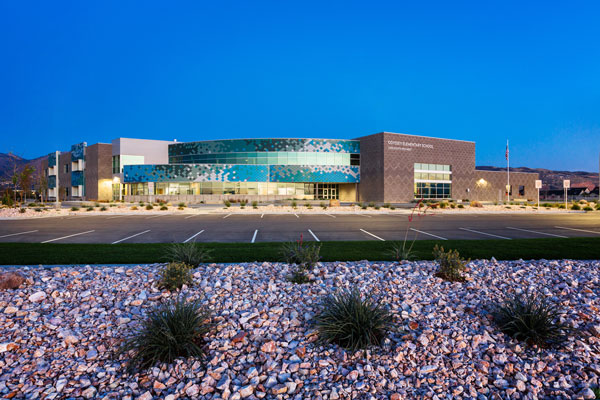It’s fitting that the first net-zero school in Utah is an elementary school. Architecture studio VCBO Architecture’s extraordinary design is a stunning ode to what conservation-savvy architects can achieve when they prioritize future generations. On top of a comprehensive carbon cutting design, Odyssey Elementary produces as much energy as it consumes via an array of 1,100 photovoltaic panels. VCBO principal Jeanne Jackson, FAIA recalls explaining to fifth graders why they wanted to install the costly $750,000 PV array, highlighting that they would zero out energy costs in a mere decade. “I showed them the figures and the payback and they said, ‘That seems like a really good investment, because after that, it’s all free.’ I think if we can get a fifth grader to see it, then we did our job,” Jackson says.
Knowing the panels were not a guarantee because of their initial price tag, Jackson and her team whittled down the energy usage of the building as much as possible from the outset. They started with emulating other low energy buildings, orientating their building properly to take advantage of passive solar heating and cooling, and outfitting every light fixture in the building with responsive LEDs. “There’s daylight harvesting, so when there’s enough daylight coming in, the lights dim or turn off,” Jackson explains. There’s likewise different controls available depending on the classroom’s needs, for instance during a presentation, the optimal lighting set up can be configured.”

Every classroom is designed with a scheme, with round group tables and stools, so kids can move freely. Research shows that you can do better work that way because there is more blood flowing, allowing students to get the most out of their education and teachers to use different platforms.
Jackson insists that the most important part of the building’s energy saving infrastructure is its ground source heat exchange loop, which uses the earth as a “heat sink,” drastically lessening the burden on applied heat and cooling to the interior temperature. The system works by running glycol into the 350-foot wells beneath Odyssey’s playfields, and using the earth’s steady 45 degrees as a base from which to heighten or lower air temperature. “If you’re trying to cool down to 65 degrees on a summer’s day, conditioning air starting from 45 degrees is a lot less intensive than starting from 90,” Jackson says. Similarly, when heating a building when outdoor air temperatures dip below freezing, a well-insulated envelope filled with polyiso spray foam and high performance double-glazed windows help keep conditioned air from leaking.

The school’s four wings, playfully called “habitats” with the names “run, jump, swim, and fly,” are meant to encourage movement and exercise.
PROJECT
Client Davis School District
Size 84,785 ft²
Cost $13.1 million
Certification LEED Gold anticipated
Completion 2014
TEAM
Architect VCBO Architecture
Mechanical Engineering Van Boerum & Frank Associates, Inc.
Electrical Engineering Envision Engineering
Structural Engineering Bsumek Mu & Associates
Landscape Architect ArcSitio Design
Contractor Hughes General Contractor
SUPPLIERS
Carpet Mohawk
Floors Johnsonite
Masonry Amcor (Oldcastle)
Ceilings CertainTeed
Ceramic Tiles Dalile
Door Hardware Ingersoll-Rand
Doors Steelcraft, Overhead Door Co.
Elevators Schindler Elevator Corporation
Insulation Icynene, CertainTeed
Movable Partitions ModernFold
Paint Kwalpaint
Roofing Sika Samafil
Skylights Solatube, Sun Optics
Windows EFCO
Hand Drying Equipment Dyson
When it comes to water conservation, Odyssey is no slouch either. “We are in a desert,” Jackson says. “We don’t like to use a lot of water.” From low-flow fixtures to native plants on the school grounds, the team kept water usage to a minimum. They did, of course, want green grass for children to enjoy, but even the water-intensive lawns are monitored by evapotranspiration, where sensors in the landscaping keep track of soil dryness, and only turn on the sprinklers when necessary.
Jackson, who only designs K-12 facilities, underscores that Odyssey’s engagement with the kids’ present and future goes beyond the sustainability of their environs and is built into the foundation of their experience. Prior to the building’s construction, a committee meditated on the childhood epidemic of obesity and settled on the thematic concept of motion and what it means to kids. The school’s four wings, playfully called “habitats” with the names “run, jump, swim, and fly” are meant to encourage movement and exercise. The animal kingdom’s cast of characters also helped bring their vision to life. “In every classroom, we designed a scheme with round group tables and stools, so kids can move freely and can fidget,” Jackson says. “Research shows that you can do better work that way because there is more blood flowing. It allows students to get the most out of their education and teachers to use different platforms.”
Perhaps the most inspiring thing about Odyssey, besides that children will have likely have a blast there, is that it demonstrates what a great investment it is financially for buildings to utilize green technology and design principles. “An average school in Utah costs about $1-per-square-foot-per-year to run utilities,” Jackson says. “We’re at $0.37-per-square-foot-per-year.” This massive energy reduction means that Odyssey and schools like it (there are two others following the same prototype currently in the works) will be able to recover the costs of their PV array in about 12–14 years. Additionally, energy costs will likely double every 10 years, Jackson points out, whereas a net zero, well insulated building like Odyssey will be set for the next 75 years. “It’s the most exciting project I’ve ever worked on,” Jackson beams. “It’s themed; it’s fun. It’s everything.”

